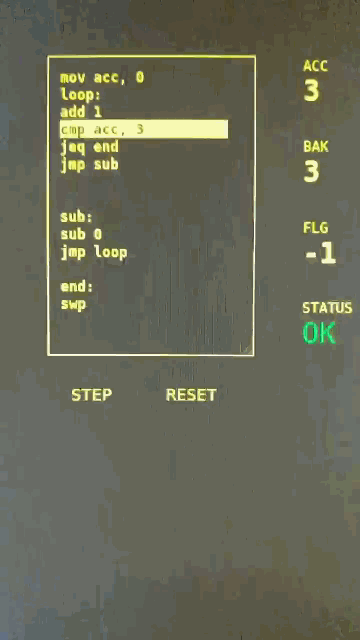Virtual Assembler Interpreter in Javascript (VASM)
This project implements a fictional assembler language interpreter in javascript. The main purpose of this project is to get acquainted with (toy) assembler languages, and the concepts behind it.
Quickstart
Everything is handled and done via make and docker. To install emberjs, call
the target:
make install.emberThis will create a new docker image called emberjs in your local docker repository. Next the application needs to be build. Run
make setupThis will install all npm dependencies.
To launch the application just run:
make
This will start ember serve on the code repository. A small message will show on the console, how to access the application via the browsers.
Per default it should be http://localhost:4200
Instruction Set
The following tables give an overview of the instructions, the memory layout, and the registers.
abbreviations
- Register (R)
- Number (N)
| OpCode | Description |
|---|---|
| jmp | unconditional jump |
| jeq | jump, if FLG register == 0 |
| jne | jump, if FLG register != 0 |
| jez | jump, if FLG register == 0 (?) |
| jgz | jump, if FLG register > 0 |
| jlz | jump, if FLG register < 0 |
| add R / N | |
| sub R / N | |
| div R / N | |
| mul R / N | |
| mod R / N | |
| mov R, R / N | |
| tst R, R/N | tests, if target and source are the same. modifies FLG |
| swp | swaps acc and bak |
| psh | push a value to the stack |
| pop | pops a value from the stack |
| nop | no operation |
| swp R / N | swp acc with bak |
Future Opcodes (not implemented yet)
| OpCode | Description |
|---|---|
| shl R / N | shift acc left |
| shr R / N | shift acc right |
| xor R / N | (bitwise) xor acc |
| orr R / N | (bitwise) or acc |
| and R / N | (bitwise) and acc |
Registers
VASM consists of four registers
| Register | Description |
|---|---|
| ACC | A general purpose registers called the accumulator. All operations are done on this register. |
| BAK | A backup register. Cannot be directly written to, but read from. |
| FLG | The flag register. The main purpose of this register is to store information on operations done on acc. |
Future Registers
| Register | Description |
|---|---|
| (LFT) | Access data from left port |
| (RGH) | Access data from right port |
| (TOP) | Access data from top port |
| (BOT) | Access data from bottom port |
| (LST) | Access data from last port |
| (ANY) | Access data from any port, whatever provides data first |
| (ZER) | A zero registers. This mainly does nothing, when read from it provides a zero |
Example Code
The following example code initializes acc with 0
and loops, adding 1 on each iteration, swp the result of acc to
bak returning to the beginning of the list of instructions.
begin:
mov acc, 0
loop:
add 1
cmp acc, 10
jeq end
jmp loop
end:
swp
jmp begin
Parser Internals
The VASM parsers is technically a LR(1) parser that reads a symbol at a time, looks the next symbol(token), and creates an instruction in form of a javascript function, that will be pushed at the end of the list of instructions. It sucessfully handles labels (jump targets), by pushing the seen label into a temporary stack. If the next token is an instruction, the temporary label stack is being cleared, and the respective label will be stored with the address of that instruction ( which effectively simulates the program counter or "pc"). Since, we simply do not to handle memory addresses directly ( but indeces of the list of instructions), we don't have to calculate the memory offsets all by ourselfes, which makes things quite easy.
TODO
- convert logic into ember component
